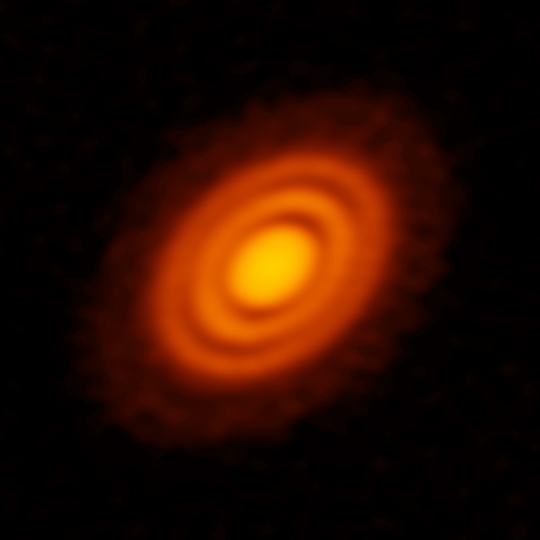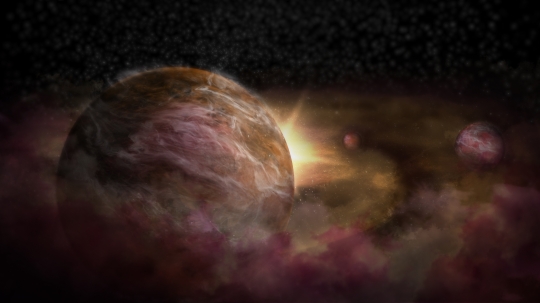Some 4 million years old, the star HD 163296 is about 330 light years out in the direction of the constellation Sagittarius. When dealing with stars this young, astronomers have had success with data from the Atacama Large Millimeter/submillimeter Array (ALMA), teasing out features in protoplanetary disks filled with gas and dust, the breeding ground of new planets. As seen below, the ALMA imagery can be striking, a closeup look at a stellar system in formation.

Image: ALMA image of the protoplanetary disk surrounding the young star HD 163296 as seen in dust. Credit: ALMA (ESO/NAOJ/NRAO); A. Isella; B. Saxton (NRAO/AUI/NSF).
Tantalizingly, ALMA can show us rings in such disks, and the gaps that imply an emerging planet. But how do we know we’re actually looking at planets, rather than other phenomena we’re only now learning how to detect in such disks? New work from Richard Teague (University of Michigan) as well as a second effort by Christophe Pinte and team (Monash University, Australia) points us strongly toward the protoplanet interpretation. Both papers are in process at Astrophysical Journal Letters and available as preprints (see below).
In each case, the focus is not on the dust that is so visible in the image above but the distribution of carbon monoxide (CO) gas throughout the HD 163296 disk structure. ALMA is able to detect the millimeter-wavelength light that molecules of CO emit, while wavelength changes owing to the Doppler effect make it possible to discern the movement of the gas within the disk. Calling the precision involved in these studies ‘mind boggling,’ Teague coauthor Til Birnstiel (University Observatory of Munich) notes that in a system where gas rotates at about 5 kilometers per second, ALMA detected velocity changes as small as a few meters per second.
“Although dust plays an important role in planet formation and provides invaluable information, gas accounts for 99 percent of a protoplanetary disks’ mass,” says Teague coauthor Jaehan Bae of the Carnegie Institute for Science. “It is therefore crucial to study kinematics of the gas.”
Teague and team found disruption in the Keplerian rotation that gas would be expected to show, the orderly motion of objects around a central star. The emergence of localized disturbances within the gas would provide evidence for a planet in the making. And indeed, the researchers found two distinct patterns, one at roughly 80 AU, the other at 140 AU. Meanwhile, the team led by Christophe Pinte — likewise looking at anomalies in the flow of gas through detection of CO emissions rather than dust — detected a third planet-like pattern, this one at 260 AU. All three worlds, the scientists calculate, would be approximately similar in mass to Jupiter.

Image: Artist impression of protoplanets forming around a young star. Credit: NRAO/AUI/NSF; S. Dagnello.
We’re out on the edge here, just as exoplanet hunting itself was in the early 1990s as we approached the first detections. These days we can use radial velocity, transits and gravitational microlensing to spot planets, with the number of confirmed worlds rising steadily. Protoplanets are another story altogether, although the evidence for them continues to mount. The Teague paper explains the significance of the CO studies:
We have presented a new method which enables the direct measurement of the gas pressure profile. This allows for significantly tighter, and more accurate, constraints on the gas surface density profile than traditional methods. Furthermore, as this method is sensitive to the gap profile, it provides essential information about the gap width in the gas which is typically poorly constrained from brightness profiles.
And indeed, what the work gives us is a way to measure changes in the gas velocity and density that correlate to the observed perturbations in the protoplanetary disk. Pinte’s team, meanwhile, working with measurements of CO velocity in the disk, found a 15 percent deviation from expected Keplerian flow. The possible protoplanet they detect at approximately 260 AU could conceivably be detected via direct imaging. If it is, the question of its formation is interesting:
Can massive planets form at a distance of 250 au from the star? The location of giant planets in the outer regions of discs would be broadly consistent with gravitational instability. On the other hand, the timescale for core accretion may also be reasonable given that HD 163296 is a relatively old disc (≈ 5 Myr). The planet may also have undergone outward migration, depending upon the initial profile of the disc. It is beyond the scope of this Letter to speculate further.
Measuring the velocity of carbon monoxide in a protoplanetary disk is an indication of how fine-grained the ALMA data on HD 163296 are. The comparison of these observations with computer models show a fit with the patterns that would be expected for young planets. The evidence is not yet conclusive, but it’s clear that the developing science of protoplanet detection is gaining traction. Applying these methods to other well-defined disks should tell us more.
The papers are Teague et al., “A Kinematic Detection of Two Unseen Jupiter Mass Embedded Protoplanets” (preprint) and Pinte et al., “Kinematic evidence for an embedded protoplanet in a circumstellar disc” (preprint), both accepted at Astrophysical Journal Letters.



What is the difference between a planet, a protoplanet, a planetary embryo and a planetesimal?
‘What is the difference between a planet, a protoplanet, a planetary embryo and a planetesimal?’
Size, mass and temperature or the start of a good joke :)
And don’t forget “planemo”–that’s another term that has been used (although it may have to do with Pluto-like objects).
Interesting work! I am looking forward to the era when direct detection happens regularly. Is there an estimate of the parent star’s mass?
About 2 solar masses, I believe.
The NEXT next detection frontier would obviously be exomoons! FINALLY some news on Kepler 1625b I(sort of). ArXiv: 1806.04672- “Revisiting the exomoon candidate signal around Kepler-1625b.” by Kei Rodenbeck, Rene Heller, Michael Hippke, Laurent Gizon. Still favors the 2 object(i.e., planet-moon) scenario over the one object(planet ONLY)scenario, but with VERY serious concerns about “detrending”(whatever the heck that is). Kipping tweeted in response “…we introduce method marginalized detrending…”(whatever the heck THAT is) which apparently will be used FOR THE FIRST TIME in their upcoming HST observations paper.
https://arxiv.org/abs/1806.04672
Revisiting the exomoon candidate signal around Kepler-1625b
Kai Rodenbeck (1,2), René Heller (1), Michael Hippke (3), Laurent Gizon (1,2) ((1) Max Planck Institute for Solar System Research (2) Institute for Astrophysics, Georg August University Göttingen (3) Sonneberg Observatory)
(Submitted on 12 Jun 2018)
Transit photometry of the exoplanet candidate Kepler-1625b has recently been interpreted to show hints of a moon. We aim to clarify whether the exomoon-like signal is really caused by a large object in orbit around Kepler-1625b. We explore several detrending procedures, i.e. polynomials and the Cosine Filtering with Autocorrelation Minimization (CoFiAM). We then supply a light curve simulator with the co-planar orbital dynamics of the system and fit the resulting planet-moon transit light curves to the Kepler data. We employ the Bayesian Information Criterion (BIC) to assess whether a single planet or a planet-moon system is a more likely interpretation of the light curve variations.
We carry out a blind hare-and-hounds exercise using many noise realizations by injecting simulated transits into different out-of-transit parts of the original Kepler-1625 data: 100 sequences with 3 synthetic transits of a Kepler-1625b-like planet and 100 sequences with 3 synthetic transits of this planet with a Neptune-sized moon. The statistical significance and characteristics of the exomoon-like signal strongly depend on the detrending method, and the data chosen for detrending, and on the treatment of gaps in the light curve.
Our injection-retrieval experiment shows evidence for moons in about 10% of those light curves that do not contain an injected moon. Strikingly, many of these false-positive moons resemble the exomoon candidate. We recover up to about half of the injected moons, depending on the detrending method, with radii and orbital distances broadly corresponding to the injected values. A ? BIC of -4.9 for the CoFiAM-based detrending indicates an exomoon around Kepler-1625b.
This solution, however, is only one out of many and we find very different solutions depending on the details of the detrending method. It is worrying that the detrending is key to the interpretation of the data.
Comments: 16 pages, 12 figures. Submitted to A&A
Subjects: Earth and Planetary Astrophysics (astro-ph.EP); Solar and Stellar Astrophysics (astro-ph.SR)
Cite as: arXiv:1806.04672 [astro-ph.EP]
(or arXiv:1806.04672v1 [astro-ph.EP] for this version)
Submission history
From: Kai Rodenbeck [view email]
[v1] Tue, 12 Jun 2018 10:44:22 GMT (3810kb,D)
https://arxiv.org/pdf/1806.04672.pdf
Are there other potential explanations for the features found in this disk that do not involve nascent planets? Or, is the planet explanation by far the most plausible?